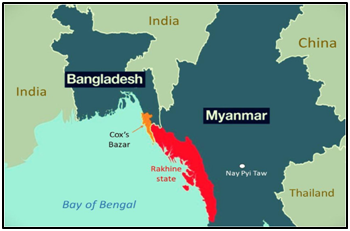Last week, a wooden boat capsized off the Indonesian coast carrying Rohingya refugees. This has once again drawn attention to the plight of the refugees who are increasingly embarking on dangerous sea journeys to seek a better life.
As per the United Nations High Commissioner for Refugees (UNHCR), over 4,500 Rohingya refugees set off on dangerous journeys across the Bay of Bengal and the Andaman Sea last year.
What’s in Today’s Article?
- About Rohingya Refugees (Background, Present Status, w.r.t. India, etc.)
- Reasons for Taking Sea Route, Death Toll, etc.
About Rohingya Refugees:
- The Rohingya are a Muslim minority ethnic group with their roots in the Arakan kingdom in Myanmar, formerly known as Burma.
- The Rohingya are culturally and religiously distinct from the majority Buddhist population in Myanmar.
- The Rohingya claim to have lived in Myanmar’s Rakhine State for generations, but successive governments in the country have disputed their ties, labelling them illegal immigrants from Bangladesh.
- Myanmar has refused to recognise them, denying them citizenship since 1982, thus making them the world’s largest stateless population devoid of fundamental rights and security.
- Their largest exodus began in August 2017 when a massive wave of violence broke out in Rakhine, driving more than 7.5 lakh people to seek sanctuary in Bangladesh to escape the brutality of security forces.
- A 2018 UN fact-finding commission claimed the Myanmar government had “genocidal” intent against the Rohingya.
Rohingyas in India:
- As per the Ministry of Home Affairs, there are more than 40,000 Rohingya in India. Only 14,000 of them hold United Nations High Commissioner for Refugees (UNHCR) refugee ID cards, which offers them protection from arbitrary detention.
- There are clusters of Rohingya population in Jammu, Hyderabad, and Delhi-NCR, besides the states of Haryana, Uttar Pradesh, and Rajasthan.
- The UN says that India has an international legal obligation to provide Rohingya refugees with necessary protection.
Legal Provisions for ‘Refugees’ in India:
- In India, no legislation has been passed that specifically refers to refugees.
- Hence, Rohingya refugees are often clubbed with illegal immigrants deported by the Government under the Foreigners Act, 1946 and the Foreigners Order, 1948.
- Section 3 of The Foreigners Act, 1946 gives the Central government the right to deport a foreign national.
- The power to identify and deport foreign nationals who are in India illegally has been delegated to state governments, Union Territories and the Home Ministry’s Bureau of Immigration.
- Illegal immigrants who are intercepted at the border while entering India unauthorizedly can be sent back then and there.
Why are Rohingyas Taking Sea Route?
- While over one million Rohingya have fled Myanmar since the 1990s, around 6 lakh remain in the country.
- They mostly live in camps for internally displaced people where their movements and livelihoods are restricted.
- An estimated 9.6 lakh Rohingya, meanwhile, reside in refugee camps in Bangladesh.
- Most live near the Myanmar border in the Cox’s Bazar, which has grown over the years to house some of the world’s largest and most densely populated refugee camps.
- These overcrowded camps lack basic human necessities, forcing the Rohingya to live in harsh conditions.
- There is a shortage of food, access to water is inadequate, sanitation facilities are missing, healthcare is insufficient, and children are growing up without formal education.
- Security conditions also have deteriorated over the years due to gang violence and an increase in arson attacks in camps.
- Over 60 Rohingya were killed in Bangladeshi camp clashes in 2023.
- With the option of returning to Myanmar virtually impossible, an increasing number of Rohingya have been undertaking dangerous journeys across the Bay of Bengal and the Andaman Sea to Muslim-majority nations of Indonesia and Malaysia.
- However, human traffickers exploit their desperation, charging exorbitant amounts to ferry them on rickety boats from Bangladesh to Indonesia.
- The treacherous voyages with inadequate space and in the absence of basic supplies take weeks and sometimes stretch into months.
- Horrifying accounts of abuse during the journey, including violence against women, have been recorded. Many do not survive the journey.
Rising Death Toll:
- The UN estimates that one in eight Rohingya who take the sea route die or disappear in the attempt, making the Andaman Sea and Bay of Bengal among the deadliest stretches of water in the world.
- Last year, the number of people embarking on sea journeys increased by 21%. The UNHCR reported a 63% increase in deaths or disappearances compared to 2022.










